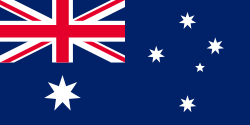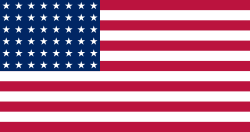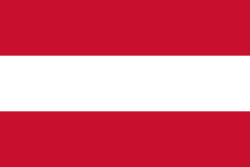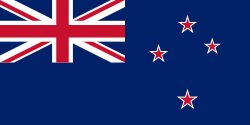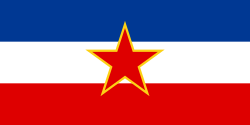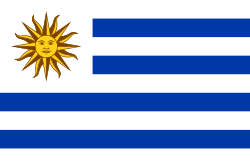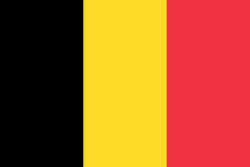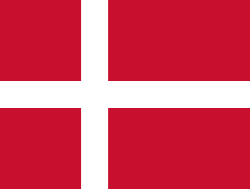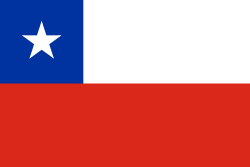Olympische Sommerspiele 1956/Rudern
| Rudern bei den XVI. Olympischen Sommerspielen | |
|---|---|
 | |
| Information | |
| Austragungsort | |
| Wettkampfstätte | Lake Wendouree |
| Nationen | 25 |
| Athleten | 242 (alle männlich) |
| Datum | 23.–27. November 1956 |
| Entscheidungen | 7 |
| ← 1952 Helsinki 1960 Rom → | |
Bei den XVI. Olympischen Spielen 1956 in Melbourne wurden sieben Wettbewerbe im Rudern ausgetragen. Zwischen dem 23. und dem 27. November 1956 traten insgesamt 242 männliche Athleten aus 25 Nationen an. Austragungsort war der Lake Wendouree nahe Ballarat.
Die erfolgreichste Nation waren die Vereinigten Staaten, deren Boote drei der sieben Wettbewerbe gewannen und sich darüber hinaus zwei Silbermedaillen und eine Bronzemedaille sicherten. Dahinter folgte die Sowjetunion mit zwei Goldmedaillen und je einer Silber- und Bronzemedaille. Jeweils ein Olympiasieg gelang Booten aus Italien und Kanada, wobei die kanadische Mannschaft auch eine Silbermedaille gewann.
Bilanz
Medaillenspiegel
| Platz | Land | Gesamt | |||
|---|---|---|---|---|---|
| 1 | 3 | 2 | 1 | 6 | |
| 2 | 2 | 1 | 1 | 4 | |
| 3 | 1 | 1 | – | 2 | |
| 4 | 1 | – | – | 1 | |
| 5 | – | 1 | 2 | 3 | |
| 6 | – | 1 | – | 1 | |
| – | 1 | – | 1 | ||
| 8 | – | – | 1 | 1 | |
| – | – | 1 | 1 | ||
| – | – | 1 | 1 |
Medaillengewinner
Ergebnisse
| Platz | Land | Sportler | Zeit (min) |
|---|---|---|---|
| 1 | Wjatscheslaw Iwanow | 8:02,5 | |
| 2 | Stuart MacKenzie | 8:07,7 | |
| 3 | John B. Kelly junior | 8:11,8 | |
| 4 | Teodor Kocerka | 8:12,9 | |
| 5 | James Hill | 9:12,5 (im Halbfinale) | |
| 6 | Klaus von Fersen | 9:23,2 (im Halbfinale) | |
| 7 | Perica Vlašić | 9:32,2 (im Halbfinale) | |
| 8 | Stefano Martinoli | 9:35,7 (im Halbfinale) |
| Platz | Land | Sportler | Zeit (min) |
|---|---|---|---|
| 1 | Alexander Berkutow Juri Tjukalow | 7:24,0 | |
| 2 | Bernard Costello James Gardiner | 7:32,2 | |
| 3 | Murray Riley Mervyn Wood | 7:37,4 | |
| 4 | Thomas Schneider Kurt Hipper | 7:41,7 | |
| 5 | Sidney Rand Bill Rand | 8:19,4 (im Halbfinale) | |
| 6 | Miguel Seijas Paulo Carvalho | 8:27,5 (im Halbfinale) | |
| 7 | Albert Krajmer František Reich | 8:38,2 (im Halbfinale) | |
| 8 | Fernand Steenacker Henri Steenacker | 9:01,9 (im Halbfinale) |
| Platz | Land | Sportler | Zeit (min) |
|---|---|---|---|
| 1 | James Fifer Duvall Hecht | 7:55,4 | |
| 2 | Igor Buldakow Wiktor Iwanow | 8:03,9 | |
| 3 | Josef Kloimstein Alfred Sageder | 8:11,8 | |
| 4 | Peter Raper Maurice Grace | 8:22,2 | |
| 5 | Reg Douglas Bob Parker | 8:44,7 (im Halbfinale) | |
| 6 | Helmut Sauermilch Claus Heß | 8:52,3 (im Halbfinale) | |
| 7 | Finn Pedersen Kjeld Østrøm | 8:55,1 (im Halbfinale) | |
| 8 | Alvaro Bianchi Maurizio Clerici | 9:11,1 (im Halbfinale) |
| Platz | Land | Sportler | Zeit (min) |
|---|---|---|---|
| 1 | Arthur Ayrault Conn Findlay Armin Seiffert (Stm.) | 8:26,1 | |
| 2 | Karl-Heinrich von Groddeck Horst Arndt Rainer Borkowsky (Stm.) | 8:29,2 | |
| 3 | Igor Jemtschuk Georgi Schilin Wladimir Petrow (Stm.) | 8:31,0 | |
| 4 | Zbigniew Schwarzer Henryk Jagodziński Bertold Mainka (Stm.) | 8:31,5 | |
| 5 | Livien Ven Antoon Ven Jos Van Thillo (Stm.) | 9:29,3 (im Halbfinale) | |
| 6 | Josef Kloimstein Alfred Sageder Franz König (Stm.) | 9:29,7 (im Halbfinale) | |
| 7 | Robert Duncan Bruce Dickson John Cockbill (Stm.) | 9:37,7 (im Halbfinale) | |
| 8 | Juan Carmona Jorge Contreras Eusebio Ojeda (Stm.) | 11:03,6 (im Halbfinale) |
| Platz | Land | Sportler | Zeit (min) |
|---|---|---|---|
| 1 | Archibald MacKinnon Lorne Loomer Walter D’Hondt Donald Arnold | 7:08,8 | |
| 2 | John Welchli John McKinlay Arthur McKinlay James McIntosh | 7:18,4 | |
| 3 | René Guissart Yves Delacour Guy Guillabert Gaston Mercier | 7:20,9 | |
| 4 | Giuseppe Moioli Attilio Cantoni Giovanni Zucchi Abbondio Marcelli | 7:22,5 | |
| 5 | Leonid Sacharow Alexander Scheff Nikolai Karassjow Igor Iwanow | 8:18,3 (im Halbfinale) | |
| 6 | Wilhelm Montag Horst Stobbe Gunther Kaschlun Manfred Fitze | 8:19,8 (im Halbfinale) | |
| 7 | John Harrison Peter Evatt Geoff Williamson Dave Anderson | 8:22,4 (im Halbfinale) | |
| 8 | Kazimierz Błasiński Szczepan Grajczyk Zbigniew Paradowski Marian Nietupski | 8:32,0 (im Halbfinale) |
| Platz | Land | Sportler | Zeit (min) |
|---|---|---|---|
| 1 | Alberto Winkler Romano Sgheiz Angelo Vanzin Franco Trincavelli Ivo Stefanoni (Stm.) | 7:19,4 | |
| 2 | Olof Larsson Gösta Eriksson Ivar Aronsson Evert Gunnarsson Bertil Göransson (Stm.) | 7:22,4 | |
| 3 | Kauko Hänninen Reino Poutanen Veli Lehtelä Toimi Pitkänen Matti Niemi (Stm.) | 7:30,9 | |
| 4 | Gordon Cowey Kevin McMahon Reg Libbis Ian Allen John Jenkinson (Stm.) | 7:31,1 | |
| 5 | Elo Tostenæs Mogens Sørensen Børge Hansen Tage Grøndahl John Vilhelmsen (Stm.) | 8:08,4 (im Halbfinale) | |
| 6 | Andrei Archipow Juri Popow Walentin Sanin Jaroslaw Tscherstwy Anatoli Fetissow (Stm.) | 8:14,0 (im Halbfinale) | |
| 7 | James Wynne Douglas Turner James McMullen Ronald Cardwell Edward Masterson (Stm.) | 8:24,3 (im Halbfinale) | |
| 8 | Peter Lucas Ray Laurent Donald Gemmell Allan Tong Colin Johnstone (Stm.) | 8:30,7 (im Halbfinale) |
| Platz | Land | Sportler | Zeit (min) |
|---|---|---|---|
| 1 | Thomas Charlton, David Wight, John Cooke, Donald Beer, Caldwell Esselstyn, Charles Grimes, Richard Wailes, Robert Morey, William Becklean (Stm.) | 6:35,2 | |
| 2 | Philip Kueber, Richard McClure, Robert Wilson, David Helliwell, Donald Pretty, William McKerlich, Douglas McDonald, Lawrence West, Carlton Ogawa (Stm.) | 6:37,1 | |
| 3 | Michael Aikman, David Boykett, Fred Benfield, James Howden, Garth Manton, Walter Howell, Adrian Monger, Brian Doyle, Harold Hewitt (Stm.) | 6:39,2 | |
| 4 | Olle Larsson, Lennart Andersson, Kjell Hansson, Rune Andersson, Lennart Hansson, Gösta Eriksson, Ivar Aronsson, Evert Gunnarsson, Bertil Göransson (Stm.) | 6:48,1 | |
| 5 | Josef Věntus, Eduard Antoch, Ctibor Reiskup, Jan Švéda, Josef Švec, Zdeněk Žára, Jan Jindra, Stanislav Lusk, Miroslav Koranda (Stm.) | 7:12,9 (im Halbfinale) | |
| 6 | Wladimir Krjukow, Georgi Guschtschenko, Anatoli Antonow, Jewgeni Samsonow, Leonid Gissen, Slawa Amiragow, Boris Fjodorow, Ernest Werbin, Wladimir Petrow (Stm.) | 7:18,3 (im Halbfinale) | |
| 7 | Antonio Amato, Salvatore Nuvoli, Cosimo Campioto, Livio Tesconi, Antonio Casuar, Giancarlo Casalini, Sergio Tagliapietra, Arrigo Menicocci, Vincenzo Rubolotta (Stm.) | 7:19,8 (im Halbfinale) | |
| 8 | Yōzō Iwasaki, Yasukuni Watanabe, Sadahiro Sunaga, Yoshiki Hiki, Takashi Imamura, Yasuhiko Takeda, Masao Hara, Jun’ichi Katō, Toshiji Eda (Stm.) | 7:24,5 (im Halbfinale) |
Weblinks
- Rudern bei den Olympischen Spielen 1956 in der Olympedia (englisch)
Auf dieser Seite verwendete Medien
Olympic Rings without "rims" (gaps between the rings), As used, eg. in the logos of the 2008 and 2016 Olympics. The colour scheme applied here was specified in 2023 guidelines.
Pictograms of Olympic sports - Rowing. This is unofficial sample picture. Images of official Olympic pictograms for 1948 Summer Olympics and all Summer Olympics since 1964 can be found in corresponding Official Reports.
Flag of Australia, when congruence with this colour chart is required (i.e. when a "less bright" version is needed).
See Flag of Australia.svg for main file information.Autor/Urheber: maix¿?, Lizenz: CC BY-SA 2.5
A silver medal with the olympic rings inside
Autor/Urheber: maix¿?, Lizenz: CC BY-SA 2.5
A bronze medal with the olympic rings inside
US Flag with 48 stars. In use for 47 years from July 4, 1912, to July 3, 1959.
(c) I, Cmapm, CC BY-SA 3.0
The flag of the Soviet Union (1955-1991) using a darker shade of red.
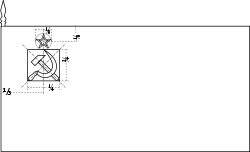
(c) I, Cmapm, CC BY-SA 3.0
The flag of the Soviet Union (1955-1991) using a darker shade of red.

The Canadian Red Ensign used between 1921 and 1957.
This image has compared for accuracy (mainly colors) using an image from World Statesmen. The only change is making the maple leaves green from red. This image has compared for accuracy (mainly colors) using an image from World Statesmen. The most recent version of this image has changed the harp into one with a female figure; see [http://flagspot.net/flags/ca-1921.html FOTW
The Canadian Red Ensign used between 1921 and 1957.
This image has compared for accuracy (mainly colors) using an image from World Statesmen. The only change is making the maple leaves green from red. This image has compared for accuracy (mainly colors) using an image from World Statesmen. The most recent version of this image has changed the harp into one with a female figure; see [http://flagspot.net/flags/ca-1921.html FOTW
Flag of Italy from 1946 to 2003, when exact colors were specified.
Flagge Österreichs mit dem Rot in den österreichischen Staatsfarben, das offiziell beim österreichischen Bundesheer in der Charakteristik „Pantone 032 C“ angeordnet war (seit Mai 2018 angeordnet in der Charakteristik „Pantone 186 C“).
Flag of Second Polish Republic and later People's Republic of Poland in period from March 29, 1928 to March 10, 1980. Red shade used here is HTML "vermilion" #E34234. Proportion 5:8.
Flag of Second Polish Republic and later People's Republic of Poland in period from March 29, 1928 to March 10, 1980. Red shade used here is HTML "vermilion" #E34234. Proportion 5:8.
Flag of the Socialist Federal Republic of Yugoslavia (1946-1992).
The design (blazon) is defined in Article 4 of the Constitution for the Republic of Yugoslavia (1946). [1]
Flagge des Vereinigten Königreichs in der Proportion 3:5, ausschließlich an Land verwendet. Auf See beträgt das richtige Verhältnis 1:2.
Flagge des Vereinigten Königreichs in der Proportion 3:5, ausschließlich an Land verwendet. Auf See beträgt das richtige Verhältnis 1:2.
Das Bild dieser Flagge lässt sich leicht mit einem Rahmen versehen
Variant version of a flag of Japan, used between January 27, 1870 and August 13, 1999 (aspect ratio 7:10).
Variant version of a flag of Japan, used between January 27, 1870 and August 13, 1999 (aspect ratio 7:10).
Olympic Rings without "rims" (gaps between the rings), As used, eg. in the logos of the 2008 and 2016 Olympics. The colour scheme applied here was specified in 2023 guidelines.
Autor/Urheber: maix¿?, Lizenz: CC BY-SA 2.5
A gold medal with the olympic rings inside
Autor/Urheber:
IOC
, Lizenz: LogoLogo der Olympischen Sommerspiele 1956 Melbourne



